Selimiye Mosque Tour To Witness A Masterpiece Of Ottoman Architecture
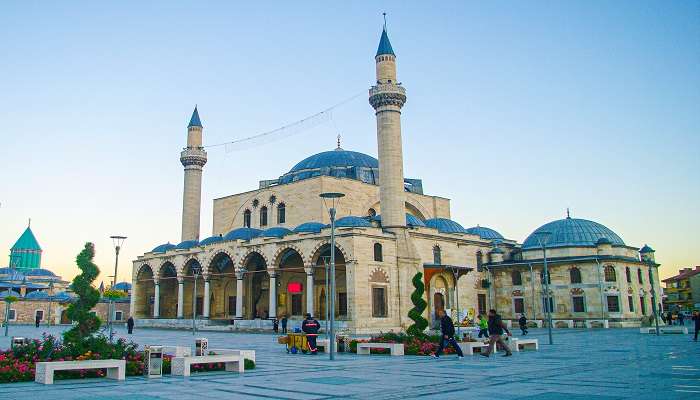
The Selimiye Mosque is an iconic Ottoman imperial mosque in the city of Edirne in Turkey. Constructed between 1568 and 1575, it was designed by the renowned Ottoman architect Mimar Sinan. This magnificent mosque is considered one of Sinan’s masterpieces and a culmination of classical Ottoman architecture. With its soaring central dome, intricate tile work, and carved marble decorations, the Selimiye Mosque is breathtaking. Its massive scale, perfect proportions, and innovative engineering solutions, such as using elephant’s feet as counterweights, make it an architectural wonder even by today’s standards. This historic mosque remains an active place of worship and a must-see destination for visitors to Edirne.
About Selimiye Mosque
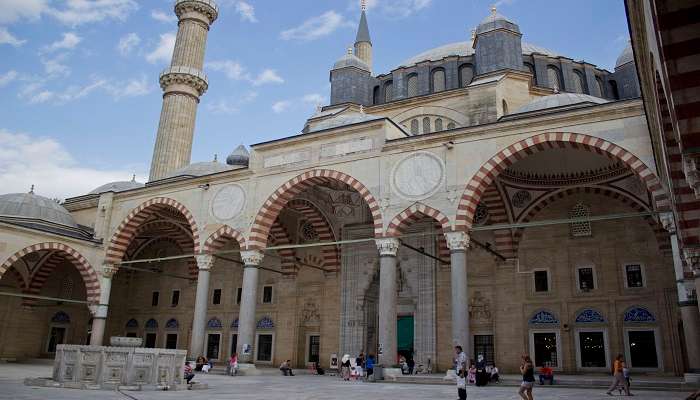
The Selimiye Mosque is an architectural masterpiece in Edirne, a testament to the zenith of Islamic and Ottoman design. It is Sinan’s magnum opus, conceived by Sultan Selim II and brought to life by the legendary architect Mimar Sinan between 1568 and 1575. Its imposing central dome soars to 43 meters, supported by four soaring minarets, each 83 meters tall. The mosque’s innovative design has earned it a place as a UNESCO World Heritage Site, symbolizing a pivotal moment in cultural history.
Must Read: Historical Caves In Turkey
Selimiye Mosque History
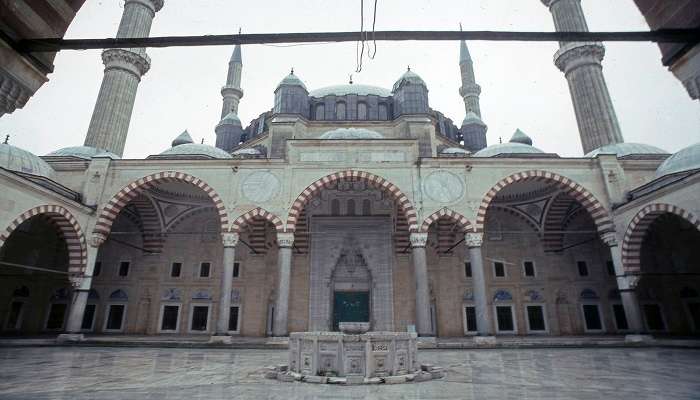
Constructed by order of Sultan Selim II, the Selimiye Mosque in Edirne is an iconic example of Ottoman architecture, completed between 1568 and 1575. The sultan preferred Edirne over Constantinople due to his affection for the city, where he had spent his princely days hunting. The chief architect, Mimar Sinan, chose Sari Tepe for the mosque’s site, ensuring a panoramic view of the Edirne Plain and taking advantage of the area’s stable geological features and strategic location. Sinan’s masterful design not only integrated the mosque with the city’s existing skyline, featuring landmarks like the Old Mosque and Üç Şerefeli Mosque but also included a commercial hub and housing. However, some of these additions have not entirely survived the test of time.
The Selimiye Complex has been preserved through various restorations, addressing damages from natural disasters, wars, and other calamities. Sinan conducted repairs following a lightning strike in 1584, and subsequent restorations were carried out after earthquakes and storms. The Turkish-Russian War saw the looting of precious decorations, and in 1913, the Selimiye Mosque dome suffered artillery damage.
However, the mosque’s sturdy construction withstood complete ruin. Mustafa Kemal Atatürk left some war scars untouched, serving as historical reminders. As the years progressed, parts of the complex were repurposed into museums, like the Selimiye Foundation Museum and the Turkish and Islamic Art Museum. The 20th century brought efforts to return the mosque’s interior to its original splendour and reinforce the dome, with recent renovations focusing on the minarets’ roofs.
Why Was The Selimiye Mosque Built?
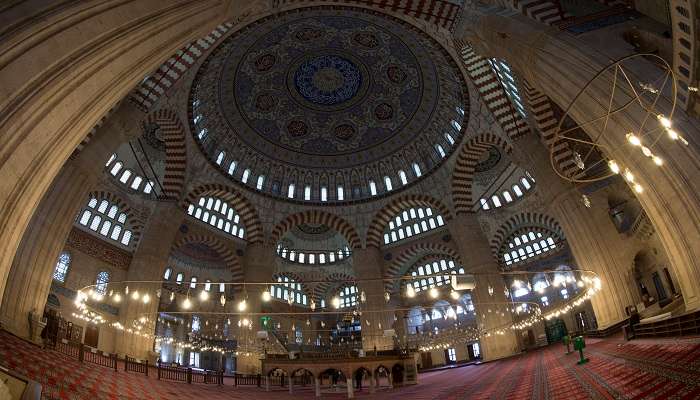
Sultan Selim II built the Selimiye Mosque as a monument to outshine the splendour of the Hagia Sophia, symbolising his sovereign legacy. He selected Edirne for its historical resonance and Istanbul’s spatial constraints; the sultan placed the mosque prominently in the city. This unifying effect exemplifies his imperial and cultural aspirations. The mosque is an emblem of creative vision and a luminary of Islamic art and architecture.
Suggested Read: Best Places To Visit In Turkey
Architecture And Design
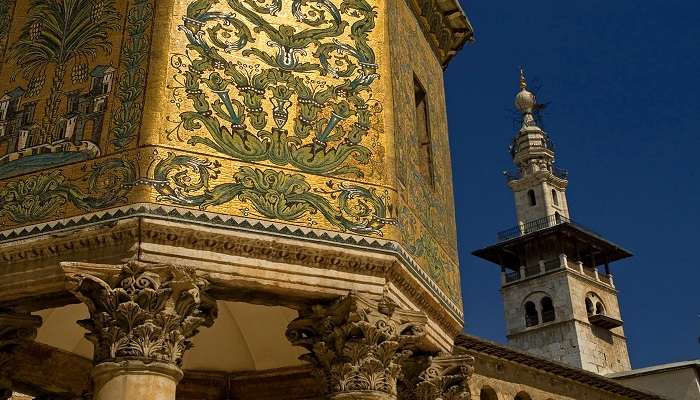
The Selimiye Mosque, a masterpiece of Ottoman architecture, is the magnum opus of the renowned architect Mimar Sinan. The mosque’s design is a harmonious blend of a vast rectangular courtyard and an equally expansive prayer hall, stretching approximately 60 by 44 meters. The courtyard, a grand prelude to the mosque, is defined by a simple yet striking northwest gate leading to a porticoed perimeter where the southeastern section towers above the rest to align with the mosque’s lofty stature.
This elevated entrance, reminiscent of a triumphal arch, is distinct from Sinan’s earlier designs, such as the one at the Süleymaniye Mosque. Intricate marble inscriptions and lunette-decorated windows, some adorned with exquisite Iznik tiles, complement the courtyard’s aesthetic. At its heart lies an ornate marble ablutions fountain, its design emphasising the Selimiye Mosque dome’s visibility, suggesting an intentional lack of a traditional roof.
Inside, the prayer hall is a testament to Sinan’s architectural ingenuity, dominated by a colossal dome unobstructed by the usual supporting structures. This innovative “octagonal baldaquin” design employs eight pillars seamlessly integrated with the mosque’s walls, allowing for many windows and creating a fluid transition to the central dome. The interior space is meticulously organised, with every element accentuating the dome’s supremacy.
The mosque’s exterior is marked by four slender minarets, among the tallest in Ottoman history, each soaring to 70.89 meters. These minarets, with their symmetrical fluting, are strategically placed at the corners of the forecourt, framing the central dome and enhancing the mosque’s vertical emphasis. Their identical design and placement highlight the mosque’s centralized plan, a departure from traditional minaret configurations, and contribute to the Selimiye Mosque’s iconic skyline.
How To Reach
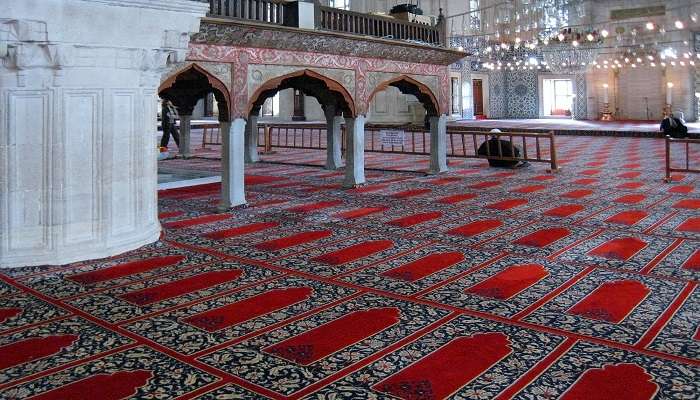
If you plan to visit the Selimiye Mosque, Turkey, from Istanbul by road, you can drive on the D-100 highway, covering a distance of about 238 kilometres. An alternative route is to take a bus from Istanbul to Edirne, where you may catch a taxi to the mosque from the bus terminal.
For those travelling from the Aegean Region, the route via Çanakkale using the D550 highway is a viable option, or you can travel from Tekirdağ, roughly 142 kilometres away from Edirne. Once in Edirne, taxis are a convenient choice for getting to the mosque, with services like Uber or BiTaksi available at your fingertips. Local buses are another option, although they may not drop you off directly at the mosque. The taxi ride from the central bus station to the mosque typically takes around 20 minutes.
Suggested Read: Cruises From Turkey
Selimiye Mosque: Entrance Fees And Timings
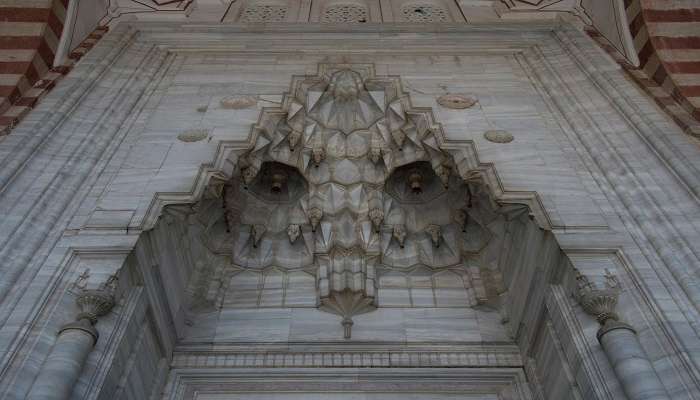
The Selimiye Mosque in Turkey is a jewel of Ottoman architecture in Edirne. It invites guests to admire its splendour free of charge. Open to the public from 10:00 a.m. to 05:00 p.m., the mosque is accessible most of the day. Visitors should be mindful of the mosque’s religious functions, particularly on Fridays, and plan their visits around the Muslim prayer times to ensure they respect the worship practices.
Best Time To Visit
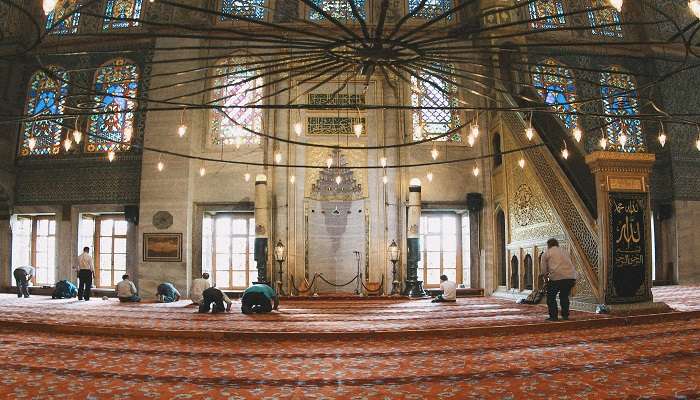
Visiting the Selimiye Mosque is particularly delightful during the summer months when the city of Edirne becomes lively with the return of European expatriates. Planning a trip in July aligns with the historic oil-wrestling festival, a highlight of Edirne’s cultural calendar for over 600 years. Thanks to extended daylight hours, this season promises an enriching cultural journey and optimal conditions for exploring the mosque.
Suggested Read: Turkey With Kids
Top Facts About Selimiye Mosque
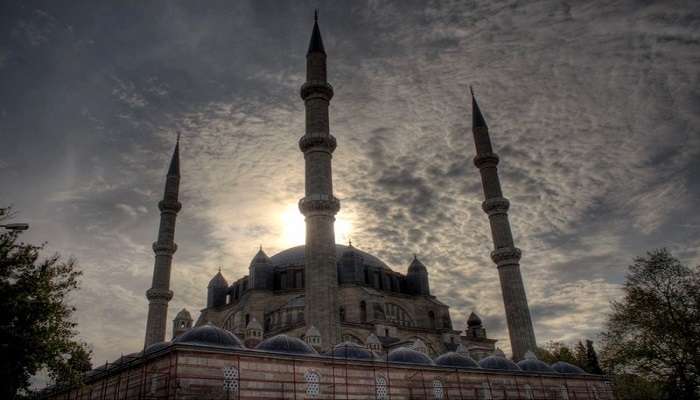
The Selimiye Mosque is a magnificent example of the pinnacle of Ottoman architecture and the ingenious work of Mimar Sinan, the empire’s most distinguished architect. Some captivating details about this architectural wonder:
- Architectural Triumph: The Selimiye Mosque, a project initiated by Sultan Selim II, was built from 1568 to 1575 and stands as Mimar Sinan’s masterpiece.
- UNESCO World Heritage Recognition: This mosque and its associated complex have been honoured as a UNESCO World Heritage Site, celebrated for their exceptional global significance.
- Dome Engineering Marvel: The mosque features one of the world’s most giant domes. It is remarkably constructed without supporting half-domes, setting it apart in mosque architecture.
- Prominent Sitting: Erected atop a hill in Edirne, the mosque dominates the city’s skyline, signifying its prominence and magnificence.
- Cultural Beacon: Its four soaring minarets, each at a height of 71 meters, enhance its stately presence and symbolize its role as a spiritual guide.
Further Read: Turkey Waterfalls
The Selimiye Mosque is a breathtaking Ottoman masterpiece in Edirne, Turkey. It captivates visitors with its towering minarets, exquisite tilework, and awe-inspiring interior adorned with calligraphic inscriptions. This architectural marvel transports you to an era of grandeur and spirituality, showcasing the brilliance of Ottoman design and craftsmanship. Book your trip to Turkey today to immerse yourself in its rich cultural heritage. Explore ancient wonders like the Selimiye Mosque and embark on an unforgettable journey through history that will astound and inspire you.
For our editorial codes of conduct and copyright disclaimer, please click here.
Cover Image Credit: Zeynel Cebeci for Wikimedia Commons
Frequently Asked Questions About Selimiye Mosque
Why is the Selimiye Mosque important?
The Selimiye Mosque stands as a crowning achievement of Ottoman architecture, crafted by the esteemed Mimar Sinan. Its designation as a UNESCO World Heritage site underscores its groundbreaking architectural and technological design.
How big is the dome of the Selimiye Mosque?
The mosque’s dome is a marvel, spanning 31.28 meters in diameter and soaring to a height of 42.25 meters. The dome of the Selimiya Mosque is the same as the Hagia Sophia’s main dome.
When was the Selimiye Mosque built?
Initiated in 1568, the construction of this architectural gem was completed seven years later, in 1575. It is the Masterpiece of Sinan and is considered as the highest achievement of Islamic architecture.
What are the notable features of the Selimiye Mosque in Edirne?
The mosque boasts a magnificent central dome, a quartet of towering minarets that punctuate the skyline of Edirne, a grand courtyard featuring a decorative marble fountain, and exquisite interior adornments with Iznik tiles, reflecting the zenith of their craft.
What is the architecture of the Selimiye Mosque?
The mosque exhibits a harmonious square layout, anchored by a grand dome upheld by eight robust pillars. Four minarets, each reaching 71 meters, complement the architectural plan, masterfully inviting a flood of natural light and accentuating the mosque’s elaborate artistry and craftsmanship.
People Also Read:
Sheikh Zayed Mosque Grand Mosque Dubai Moorish Mosque

Unveil the hidden treasures of the globe and turn every travel dream into reality. As a Content Writer, I am passionate enough to craft stories from ancient wonders to modern marvels. My words paint the picture-perfect itinerary for unforgettable experiences. Let my words be your trusted guide to immerse in the diverse culture and discover the beauty of the unknown.











